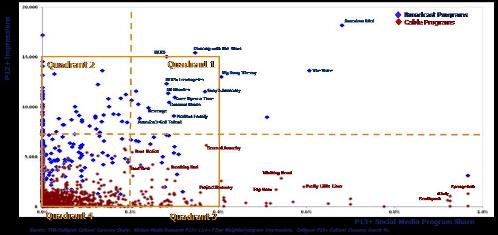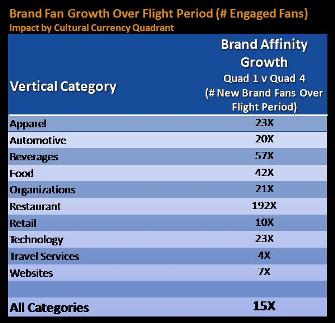Cultural Currency – There's Still Magic in Mass - Stacey Lynn Schulman-TVB

Are you riding the Twitter feed while watching the season finale of your favorite show this month? Or maybe you're a science fiction fan, debating the relative merits of the latest storyline changes on Facebook? For mass media and the marketing industry that supports it, social networking represents the latest opportunity to keep consumers "engaged" – that elusive concept of "stickiness" that mollifies our fears of consumer distraction - and rightfully so. In today's world of digitization, personalization and customization, the competition for attention is fierce. Consumers today have both choice and depth, but the cost of satisfying our individualism is true connection. Have you been out to dinner lately and watched that couple on a date at the table next to you … texting… in silence? Evan at our local bistro, technology keeps us connected at arms-length. Employees tele-commute from home without the human interaction of co-workers, people make friends by clicking buttons more often than shaking hands, and "share" is more instant publishing than it is a reciprocal experience.
Why is this relevant to media and marketing? Because in this hyper-personalized milieu, it is the mass media that now provide the building blocks of interpersonal relevance. In the absence of sharing an experience in physical space and time, virtual social friends "connect" and bond through what is easily known – the products of our mass culture industries – film, music and television. It is here that we begin to see how Culture becomes Currency and why there will always be a need for its mass production. So while social media provide the infrastructure to connect, it is the mass media that provide our common ground. Together, the confluence of these two media provide for a powerful platform with which to both quantify and analyze the power of cultural currency on both a national and local level.
The Television Bureau of Advertising (TVB) recently explored the concept of Cultural Currency in an extensive proprietary study of social media behaviors relative to consumer brands, television, radio and newspaper content. With the help of Colligent, a social media affinity mapping company, social media behaviors were culled from Facebook and Twitter, allowing a more global view of social media activity and the inter-relationship between television and brand fans. In the television landscape alone, the study analyzed 570 TV stations and 4400+ primetime programs in both broadcast and cable during 2012.
Can media investment based on Cultural Currency actually increase a brand's fan base? It can. In the chart below, TVB mapped the Cultural Currency values of primetime television shows and divided the map into four quadrants. The quadrants differentiated the various programs based on audience size and share of engaged fan behavior across the primetime television landscape. Quadrant 1 contained programs with the largest audiences and highest share of engaged fan behavior, Quadrant 4, the least. Not surprisingly, big TV hits generated the highest degree of Cultural Currency, attracting the largest audiences with significant engagement. Youth oriented programs primarily occupied Quadrant 3, attracting the most highly engaged audiences on social media platforms – an affirmation that there is still a youthful bias in the social media user base.
The Cultural Currency Map of Primetime Entertainment Television

To understand whether the Cultural Currency map had any bearing on brand marketing success, TVB analyzed all brand spending in 2012 and isolated its analysis to only those advertisers who spent nearly exclusively (70%+) on programming in a single quadrant. The effects were dramatic. Advertisers spending nearly exclusively in Quadrant 1 generated 15 times more brand fans during their flight periods than those who advertised exclusively in Quadrant 4. These effects varied by advertiser vertical, with categories garnering from 4 times to 192 times more brand fans. These effects are mirrored at the local DMA level as well. Clearly, advertisers benefit in environments where Cultural Currency is greatest.
spent nearly exclusively (70%+) on programming in a single quadrant. The effects were dramatic. Advertisers spending nearly exclusively in Quadrant 1 generated 15 times more brand fans during their flight periods than those who advertised exclusively in Quadrant 4. These effects varied by advertiser vertical, with categories garnering from 4 times to 192 times more brand fans. These effects are mirrored at the local DMA level as well. Clearly, advertisers benefit in environments where Cultural Currency is greatest.
Measuring Cultural Currency reinvigorates the way we look at mass reach media in the context of all available communication channels. In our eagerness to identify and address every consumer prospect on an individual level, we've lost some perspective on the power of common ground that only mass cultural products can deliver. Maximizing Cultural Currency in media selection can help brands transcend the on-air moment and gain tangible traction with consumers. Broadcast television is a valuable partner in this regard, from national programming that provides the common ground to make connections to local TV stations that amplify the common ground to buildscommunity.
For more information about TVB's Cultural Currency study, visit http://www.tvb.org/measurement/cultural_currency_study
Stacey Lynn Schulman is Chief Research Officer at TVB, where she is responsible for driving insights and media research thought-leadership about the value of Local Broadcast Television across platforms. Stacey can be reached at Stacey@tvb.org.
Read all Stacey's MediaBizBloggers commentaries at Local Matters.
Check us out on Facebook at MediaBizBloggers.com
Follow our Twitter updates @MediaBizBlogger
The opinions and points of view expressed in this commentary are exclusively the views of the author and do not necessarily represent the views of MediaBizBloggers.com management or associated bloggers. MediaBizBloggers is an open thought leadership platform and readers may share their comments and opinions in response to all commentaries.


